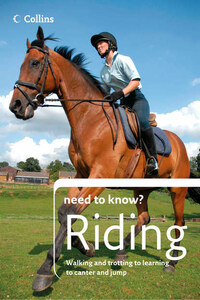Riding

This practical and accessible book is the ultimate guide to riding safely and confidently. Produced in association with the British Horse Society, this book will appeal to beginners of all ages, as well as more experienced riders who want to improve their horsemanship and expand their knowledge.Collins need to know? Riding is full of expert advice and specially-commissioned colour photographs to explain and demonstrate all aspects of riding. From making informed choices about selecting a riding school to mastering the basics and building on them to become a better rider, author Margaret Linington-Payne, Director of Standards at the BHS, gives you up-to-date information on everything you need to know.Contents include:• Selecting a riding school• Preparing to ride• Your first lesson: the basics• Learning to walk, halt, trot and canter• Progressing and getting the most out of your lessons• Refining your riding skills• Hacking out• Learning to jumpPlus handy glossary and directory of contacts and resources.







